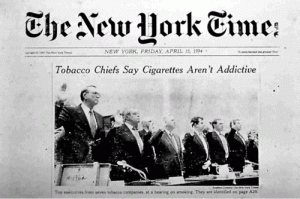The Master Settlement Agreement and E-Cigs

So some regulators are suggesting that the Tobacco Master Settlement Agreement should be modified to now included electronic cigarettes and the companies producing them. This seems extraordinarily unlikely to happen, and if it does, it seems unlikely to hold up against any scrutiny in the courts. Among other issues is that the agreement was created long before electronic cigarettes were ever a thing to be considered in tobacco legislation.
The Tobacco Master Settlement Agreement was signed in November of 1998 and essentially designated the terms of punishment for the four major tobacco companies in the US for their decades of subversive marketing to children and teens, hiding health data on the impacts of smoking, and more. It fined them $206 billion to be paid over 25 years and outlined some major restrictions on tobacco marketing and industry lobbying.
Here’s how some of the details of the agreement might apply to electronic cigarettes if regulators attempted to apply its resolutions of the industry.
 E-Cig companies might incur fines for tobacco industry sins. There’s still 11 years to go on payment of the $206 billion fine which the tobacco industry received for all the wrong it did and the profits it reaped in the time that it did it. You couldn’t apply the master settlement to e-cig companies without asking them to foot part of the bill. It works out to roughly $7.5 billion a year. That might not be much for Big Tobacco, which is used to the cost and agreed to pay it, but it only makes competition with them that much more impossible. This is yet another reason applying the agreement to e-cig companies wouldn’t fly with the courts. E-cig companies didn’t exist when the agreement was forged, so they couldn’t have committed the sins that the fine is there to punish.
E-Cig companies might incur fines for tobacco industry sins. There’s still 11 years to go on payment of the $206 billion fine which the tobacco industry received for all the wrong it did and the profits it reaped in the time that it did it. You couldn’t apply the master settlement to e-cig companies without asking them to foot part of the bill. It works out to roughly $7.5 billion a year. That might not be much for Big Tobacco, which is used to the cost and agreed to pay it, but it only makes competition with them that much more impossible. This is yet another reason applying the agreement to e-cig companies wouldn’t fly with the courts. E-cig companies didn’t exist when the agreement was forged, so they couldn’t have committed the sins that the fine is there to punish.
E-cig companies would be restricted in the trade organizations they could create and join and the activities of these organizations would be limited compared to others. Another thing the master settlement did was to restrict the organizing and lobbying capability of the tobacco industry — so much so that the creation of the master settlement forced three tobacco-specific organizations to dissolve. Yet again, applying the master settlement to e-cigs and the e-cig industry is only detrimental to the small guys (who then further lose their voice in regulatory matters), and doesn’t fit the original intent of the agreement.
E-cigs are protected from class-action and aggregate lawsuits. Despite most companies being very clear that electronic cigarettes are not harmless, people may eventually find a long-term effect of e-cig use and decide they deserve payback. The master settlement may protect the industry from large scale lawsuits that could arise from this hypothetical situation. It was created, in part, by the tobacco companies to admit fault and receive a punishment, but with limited long-term risk. So it includes a provision that as long as the requirements of the settlement are met (mainly, payment of the massive fine), class-actions and other large form lawsuits can’t be brought against the companies involved. While this may sound like a good thing, it may only mean that major tobacco companies (and maybe even some shady e-cig companies) can do whatever they want with the product without fear of major litigation against them.
Like so many other ideas regulators are suggesting for electronic cigarette regulation, this is another that attempts to shoehorn an entirely unique product into the space of another. It seems wildly unlikely to happen, but it is yet another possible future that treats e-cigs as tobacco products and makes it that much easier for the biggest tobacco companies out there to dominate the market with almost no possibility of competition.
Source: http://www.ecigadvanced.com/blog/the-master-settlement-agreement-and-e-cigs/
